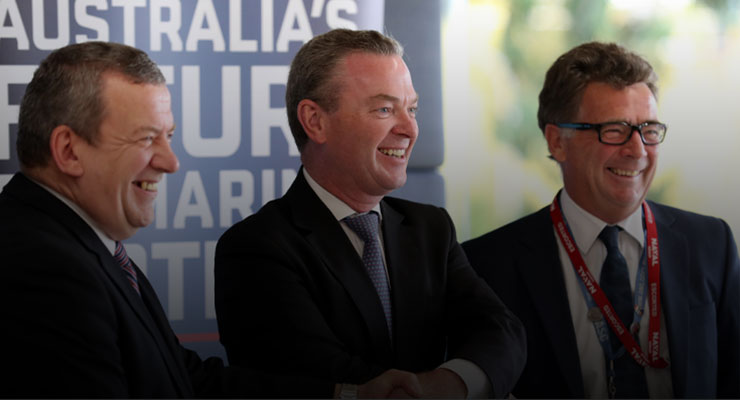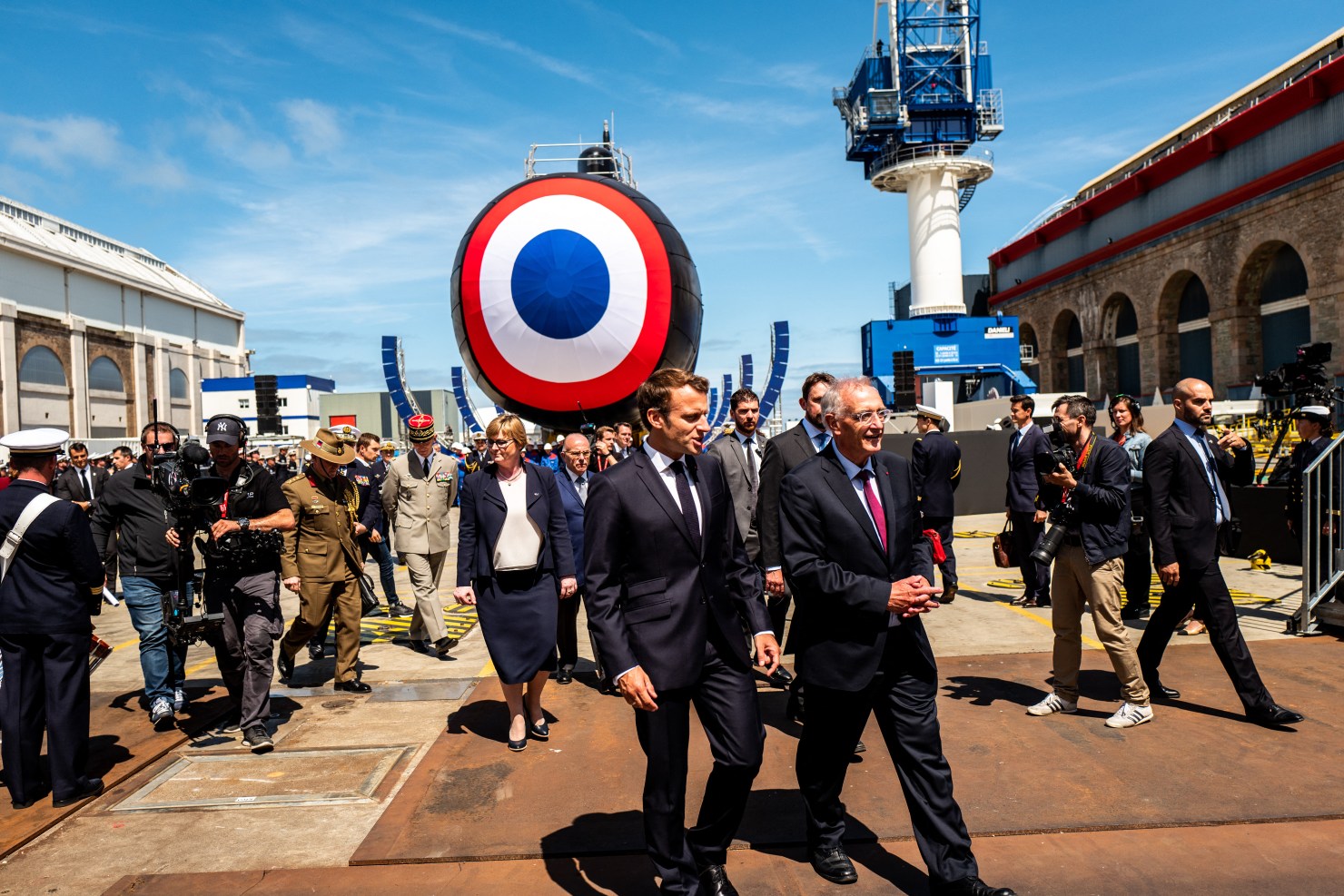
It’s one of the most lucrative contracts in Australian government history, and the largest ever defence procurement project, with a price tag equivalent to building 25 new hospitals or 3000 primary schools. But Australia’s contract with state-owned French company Naval Group to build 12 “Attack-class” submarines at a cost of $50 billion (and rising) has raised eyebrows since it was first announced in April 2016 by then-prime minister Malcolm Turnbull. And it’s now facing a further multibillion-dollar blowout, with the latest estimate sitting at around $79 billion.
Now some experts warn the new submarines — which will be designed from scratch in France but built in South Australia — could be obsolete by the time they come into action in the 2030s, with potential delays leaving Australia’s military exposed as the current fleet of Collins submarines reach the end of their life. There are even calls to reverse the deal, at a cost of millions in penalties, freeing up Australia to consider other options.
A lot of column inches and news interviews have been dedicated to the topic, with the defence community cleaved in two camps — but there are still some significant questions that need to be answered about how and why Australia agreed to such a questionable deal.
The non-tender tender
The subs “tender” as it’s commonly referred to actually wasn’t a tender at all. It was a competitive evaluation process (CEP), rushed together so quickly that not many knew what it was — or how it differed from the usual process. The key difference between the two is the CEP didn’t aim to get a full submarine design, or lock down firm costs or timelines. It’s purpose was to identify an international partner to work with, commissioning each phase of development individually. Importantly, offers could be unbinding — potentially leaving the door open to massive cost blowouts on top of what was already widely considered an extravagant budget.
Three companies were invited to compete, with the French going head to head with Japan-based Mitsubishi Heavy Industries and Kawasaki Shipbuilding and German company ThyssenKrupp Marine Systems (TKMS).
Japan had long been the favourite. But on April 26, 2016, nine months after the CEP was launched, the French were declared the winners. So what changed in these nine months?
The art of the deal
It was the beginning of the end for Tony Abbott. He had been openly boasting about Australia and Japan’s growing friendship, calling Japan Australia’s “best friend in Asia” and “ally”. Their bid to build 12 submarines was practically a done deal. It had even bolstered the support of some US officials.
The US were heavily involved in the process from the beginning, with Australia playing a key role in US defence. As senior defence analyst at the Australian Strategic Policy Institute (ASPI) Marcus Hellyer said, “we’ve had a cooperative program with the US for some time”. Both the Collins-class and the new Attack-class submarines use US combat systems — software that, as Hellyer puts it, is the “heart, core and brains” of submarines.
Some senior US officials supported the Japanese build as they, unlike the French and Germans, are not export rivals to a similar market, meaning there was less concern US technology could be leaked to competitors. Former secretary of the United States navy Professor Donald Winter was appointed to chair an independent expert advisory panel overseeing the deal. The CEP was also led by retired US rear admiral Stephen Johnson.
But soon, critics started to raise their voices. Controversially, there were plans for the Japanese submarines to be built entirely offshore, instead of at the Osborne Naval Shipyard in Adelaide, the home of Australian Submarine Corporation where the previous Collins-class submarines were constructed. South Australian politicians were furious.
The timing was important — it was the weekend before the leadership spill where Tony Abbott was tossed aside by Malcolm Turnbull, with SA Senator Sean Edwards refusing to vote for Abbott until local shipbuilders were able to participate in a tender for the contract. President Barack Obama reportedly stressed the submarine deal was a sovereign issue for Australia and there would be no implications for the alliance, no matter which bidder won.
The decision to buy Japanese subs had been a captain’s call. Abbott clung to it long after being deposed. In a speech in Tokyo in February 2016, in the middle of the CEP, he stressed Australia’s special relationship with Japan, saying its willingness to build Australia a long range version of its Soryu submarine was a sign of the “complete confidence that our countries have in each other”.
But the Japanese still had to compete with the French and the Germans. The three groups attended workshops outlining the government’s sub specifications. Bids were submitted, by hand or CD-rom for well-founded security purposes (China allegedly tried to hack each contender), with options for building in Australia, in the bidder’s home country, or a hybrid of the two.
The Japanese offered an evolved Soryu-class submarine, called the Goryu class or “Australian Dragon”. The evolved version would have diesel engines, lithium-ion batteries and be larger and capable of longer trips than the Soryu. They agreed to build all 12 submarines in Australia, and share their stealth technology, and even offered to fit the submarines with barbecues and beer fridges to sweeten the deal.
The Germans offered to upsize their Type 212A submarine. Using an air-propelled design, which is quieter than using diesel engines, and with an initial fixed price bid of $20 billion to build in Australia, TKMS seemed a likely contender.
Lastly, the French presented a variation of their Shortfin Barracuda, a nuclear-powered, lead-acid submarine, which does away with propellers all together, using nearly-silent propulsors. Incredibly power hungry, they’ve never been used with anything but nuclear — but Naval Group said they could use the same technology with diesel alternators.
When Turnbull announced the French had won the deal in April 2016, it caught Japan by surprise, with Japan’s then-defence minister Gen Nakatani describing the decision as “deeply regrettable”. So what had prompted Malcolm Turnbull to shift positions?
Turnbull claimed France had offered a submarine model with superior capabilities. These included superior sensor performance and stealth characteristics, as well as range and endurance similar to the Collins-class submarine.
So, why the French?
Naval Group offered three competitive edges. Firstly, they are experienced with blue water expeditions — long range trips through the open ocean and away from the coast. “The French have nuclear submarines which are long range, blue water submarines — their range is essentially infinite,” Hellyer said. Australia’s Collins-class submarines currently have an endurance of 80 days, necessary for the submarines to arrive at a location, gather data, and return without surfacing.
Secondly, France is the world’s third-biggest arms exporter. “They’re very accomplished exporters of weaponry. There’s not a lot of countries in the world which can make submarines or armoured vehicles by themselves — most have to go into international partnerships, whereas the French have capability to do it themselves,” Hellyer said.
Finally, the French submarines originally featured nuclear propulsion. While Australia doesn’t currently have nuclear weapons in its arsenal, there is mounting pressure from the US for Australia to develop nuclear attack design submarines, with some senior officials calling for Australia to help finance a new nuclear attack submarine program. It comes amid fears the US is falling behind in undersea warfare, particularly in the Indo-Pacific — making the ability to revert submarines back to nuclear an attractive feature.
However, many have argued converting the nuclear submarine to diesel electric is impossible, with some physicists claiming that the propulsors cannot be run on anything but nuclear.
Therefore questions have to be asked about whose interests it serves to have nuclear subs and whether there is a more long term goal at play here?

Criticism and backlash
Criticism came fast and hard. Gary Johnston, founder and CEO of Jaycar Electronics, along with businessman (and close friend) Dick Smith, John Singleton, Boyd Munro and John Tait slammed the decision in a full-page advertisement in The Australian.
“We will be condemning our sailors to their graves,” they wrote, arguing the technology — particularly, the diesel engines — would be obsolete by the time they were functional. (It’s important to note Johnston is pro-nuclear. “Australians need to get nuclear,” he told INQ. “Albanese won’t countenance nuclear power, the greenies will go nuts — it’s immaturity all round.”) Then-South Australian premier Jay Weatherill criticised the ad as looking like it was “scribbled on the back of a serviette after a long lunch”.
Johnston commissioned a report by Insight Economics, stating the CEP was anti-competitive because bidders were not required to put a price on their design. The report also found using a majority state-owned company presented its own problems, with Naval Group likely to make diplomatic decisions over commercially competitive ones. Former defence minister Christopher Pyne has denounced the experts as “armchair critics”, insisting the project is on track and within budget.
The latest blow to the project has come from one of Australia’s most trusted defence experts Hugh White, who has argued in his recent book, How to Defend Australia, that the deal should be reversed in favour of more Collins-class subs at a lower cost. “We need a lot more submarines a lot sooner than the current plans allow,” he wrote. “A military strategy of maritime denial will call for a navy very different from the one we have today and different too from the navy we are now building.”
Cost blowouts
Since Naval Group was selected to build the 12 new vessels, the project has repeatedly run into difficulties. In May last year, the Australian National Audit Office (ANAO) concluded that the submarine deal carried “high to extreme risk” due to its magnitude. It said the Defence department would struggle to contain cost, due to the “very high” premium that is incurred with a local submarine build.
Costs could easily run over budget, it said, as shipbuilders, suppliers and the Commonwealth compete for a limited pool of labour. It also pointed to a 2015 Productivity Commission report that found limited benefits in building ships in Australia compared with buying them off the shelf, saying it “diverts productive resources away from relatively more efficient uses”.
Several naval experts, including retired rear admiral Peter Briggs, have backed Johnston, who has complained to the ANAO saying the subs are wrong for Australia and the process is anti-competitive because Naval Group has not committed to any firm budget. “We’re in a sole-source design phase, and we have yet to get a price. Having a monopoly supplier is a well-known way to get a high price,” Briggs told INQ. “It’s moving at a pedestrian pace. We’ve lost time over the years which we are paying for in cost and capability.”
But according to Hellyer, eliminating competition early and not locking down a price isn’t as absurd as is being made out. “The problem with the submarine space is that there are no existing designs [for what Australia wants]. If you’re designing things that don’t exist, you don’t know what cost it will be to design or build. The provider will ask for risk provisions … they’ll come back with a huge number.”
When it comes to only commissioning one design, the ANAO found “Defence did not have the technical resources to retain two partners”. According to Hellyer, providers would also be reluctant to enter a competitive design process with less than a 50% chance of winning the contract. “From the designers perspective, they’re not going to take all their workers off another task … it’s a huge opportunity cost.”
Who is ‘Naval Group’?
The company designing and building the subs is majority owned by the French government, and a third owned by arms manufacturer Thales. Naval Group, formerly called DCNS, has a colourful past, to say the least. The company was involved in one of the largest corruption cases in French history for allegedly bribing the Taiwanese government in 1991 to win a naval contract, for which they were fined $830 million in 2010. They have also been embroiled in a Malaysian scandal involving allegations of bribery, blackmail and murder. The allegations involved a commission paid to an adviser of the then-prime minister Najib Razak to win a US$2 billion contract to build two Scorpene-class submarines for Malaysia.
Thales has separately won billions of dollars worth of contracts in Australia to build armoured four-wheel-drives, air-traffic control systems and naval ship repair operations. Last year, the company successfully lobbied federal Attorney-General Christian Porter to suppress parts of an auditor-general’s report critical of how the company spent money to build armoured vehicles.
Internationally, Thales was blacklisted between 2004 and 2005 by the World Bank Integrity Unit over fraudulent practices in a US$6.9 million motorcycle contract in Cambodia. In 2005, two of its subsidiaries were charged with corruption by prosecutors in South Africa.
Naval Group, back when it was DCNS, suffered a leak of thousands of classified documents on the Scorpene submarines being built for the Indian government. The documents outlined the technical capabilities of the top-secret subs.
Questions are now being raised about whether Naval Group is a company that can be trusted with state secrets.
The revolving door
Several senior Liberal Party insiders have circled the submarine deal since its inception. Sean Costello, former chief of staff to former defence minister David Johnston, joined Naval Group’s Australian arm in March 2015 within months of leaving his ministerial post. He remained the CEO of the company until March 2017.
And late last year, as negotiations around a so-called strategic partnering agreement stalled, Naval Group hired former Liberal candidate and confidante of Scott Morrison, David Gazard, as a consultant. Gazard, who is part of Peter Costello’s lobby group, ECG Advisory, was reportedly hired by the French shipbuilder to help improve its rocky relationship with the Defence department. Things had become so fraught that Pyne had refused to meet top French officials during a visit to the country, according to the ABC. The strategic partnering agreement was crucial for getting design contracts finalised so that submarine construction could begin. It was finally signed in February.
Do you have information about this story that you’d like to confidentially share? Get in touch.









There are cheaper tenders for boats:
https://www.boatsales.com.au/boats/used/inflatabletender-type/https://www.boatsales.com.au/boats/used/inflatabletender-type/
Describing it as a ‘typical’ LNP bungle, to be kind, that leaves Australian tax payers footing the bill and the ADF compromised sums it up.
Utter incompetence could not be better exemplified than in the submarine replacement programme. Both weapon and role are distorted to suit political and personal self-interest with arrogance worthy of a property developer.
No clearer demonstration of the stupidity of our strategic thinking is “us” seeking to protect our sea lanes from our largest trading partner. Nor do “we” have any merchant shipping to protect, because the Coalition and globalisation (with help from Labor’s class traitors) have worked to destroy our merchant fleet to destroy unionised industries. Nor has anyone explained just why we need 12 submarines, as distinct from 6 or 8. Nor any recognition that maintaining a local submarine forces requires much the same set of skills as building them.
YET, as this author notes, this reckless waste is not for Australia’s national security but to “gather data”, obviously for the evil internal repression agencies of our Imperial suzerains. Breathtaking amounts are to be squandered on a potentially useless core function.
NOR have our eager warmongers done anything to prevent Australia being completely reliant on Chinese manufactures, nor have they laid in any fuel reserves. As we would have to capitulate within weeks, sea denial is irrelevant.
BUT none of that matters to the senior bureaucrats, Rightist media ideologues, politicians, and businesspeople. They are willing and eager traitors. Rightist media identities will switch literally in an instant from promoting capitalism to promoting the Chinese Communist Party, more politicians will seek well-paid jobs with a Chinese puppet government, while businesspeople will sell out to Chinese contractors.
Scrap it and start again, after sacking the senior managers and creating a structure that favours continuity.
Our culture of playing secrets will cost billions. Of course no one knows what we should buy, who should build it where and how, how much we should pay – it’s all terribly hush hush and let the big boys look after it. Just one word – Payne – completely demolishes this foolish pretense.
But I can see where the money will go – consultants, apparatchiks, PR, urgers, security spooks and maybe a few bob to build the bloody things. We have form of course. Perhaps Crikey could commission a refresher into the saga of the current Collins subs.
They’re continuing to mount those costly mistakes by the party claiming to be the only one capable of making business decisions. The F35, Howard’s debacle. Franking credits for companies who make massive profits but don’t pay tax; will give that to Costello. The ‘new but old, NBN; thanks Mr Turnbull. The very illegal Iraq war; courtesy of Howard. Now the Submarine contract; Turnbull and Pyne can share that one!
Oh, I forget; Morrison has kept Costello’s franking credits going along with negative gearing and wants big tax cuts for the rich. Will he now plunge us into another war costing billions just to appease his mate Trump?
We haven’t even reached 20 years of the new century and how many billions have these dumb decisions by the Conservatives (I can’t bring myself to call them Liberal) cost us in such a short time? And they still say they’re the only ones we can trust to run the economy.
Yes Rufus, and that’s just the tip, of the iceberg, of course. Incompetence or grand larceny, you decide.